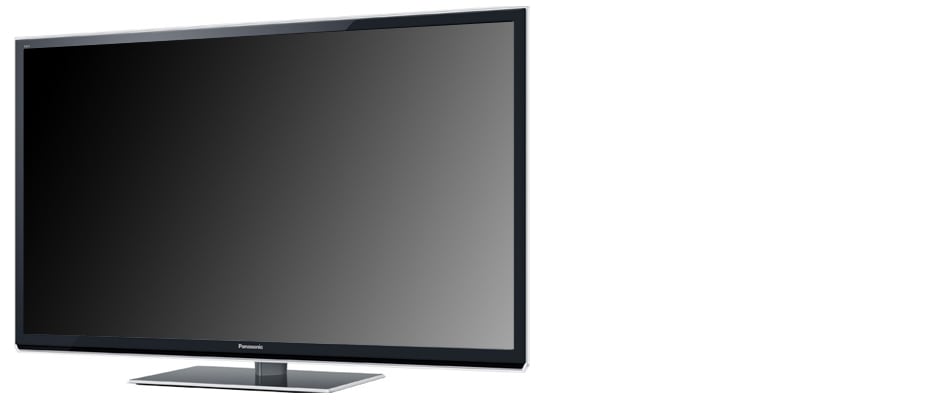Introduction
We tested this TV, going through all of it's many features inside, from Smart TV offerings to the picture performance, and found that we got less than what we expected.
Design
We are looking at a lineup of some big screens here. These large plasmas panels sit in bodies of textured gray material, with a clear glass finish. We always appreciate being able to look at something slightly modified from the typical black plastic design, and the TC-PxxST50 series sticks to what works, while adding its own classy style. There are not many ports on the back left side here, but there are enough to connect the modern devices you have.
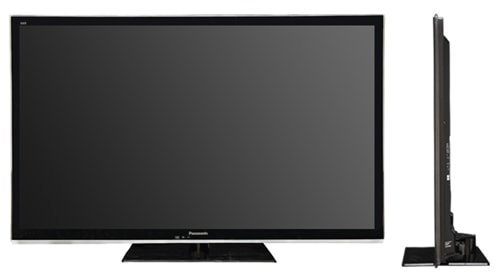
Overall Design
{{section_header}}{{section.name}}{{/section_header}}
Using a textured charcoal motif, this Panasonic plasma series executes the classic design in a style all its own. The thinness of these monstrous displays also adds to the appeal, making them more manageable for smaller spaces. The promotional materials have these displays sitting comfortably in some of the most modern living situations possible, but they are not so over-styled as to be awkward in a more classic home.
Front
{{section_header}}{{section.name}}{{/section_header}}

Back
{{section_header}}{{section.name}}{{/section_header}}

Sides
{{section_header}}{{section.name}}{{/section_header}}

Stand/Mount
{{section_header}}{{section.name}}{{/section_header}}
The stand requires three separate pieces to construct. When completed, it seems like it might swivel, especially considering it requires so many parts. We tried to see if we could turn it, but the screen is so large that we felt the torque we were creating might snap the neck of the stand before it swiveled. If this stand has some articulation, we were too cautious to try it.

On-set Controls
{{section_header}}{{section.name}}{{/section_header}}
Manual controls are always a welcome addition here at TelevisionInfo.com. There are small bumps on some of the keys to let you know what you are controlling without looking directly at the buttons. Unlike tough controls, manual controls have some great tactile feedback, and they will not leave smudgy marks on everything you own. We like the transition back to these classic controls.

Remote Control
{{section_header}}{{section.name}}{{/section_header}}
The remote is disappointingly average. A Smart TV requires a smart remote, not the same remote we have seen since the advent of remote control technology. There is so much room for innovation in this field. LG has made huge strides in this regard, setting the bar for what we feel should be a minimum of modern control.
The classic remote is limited to classic functionality, using a directional pad to control much more dynamic content. Using this remote to get to the online features is certainly doable, but it's not a great fit. Rather than revolutionizing the way we watch TV, Panasonic is slapping on advanced features without considering how the consumer will experience these new abilities.

In the Box
{{section_header}}{{section.name}}{{/section_header}}
Severely lacking in the box was a set of 3D goggles. At this point, omitting even one pair of 3D glasses is just rude. It's a slap in the face of the consumer that has dedicated the time and money to research and invest in a brand.
What we did find was a component/composite adapter cable, a paper manual, a remote, batteries, a TV, a three-part stand, warranty documents, and a very confusing amount of styrofoam.
Connectivity
{{section_header}}{{section.name}}{{/section_header}}
There are three HDMI ports and two USB ports on the side part of the connections layout, on the back of the {{product.name}}. These ports are standard for televisions these days. There are a couple of unusual choices back there too though. Panasonic, being a prominent digital camera company, has a spot for an SD card, accepting SD, SDHC, and SDXC cards.

We immediately noticed the lack of a PC connection, like a VGA port. Connecting a computer to a television is a very popular pastime for enthusiasts, being able to show any content from the hard drive, or internet movies. We assume that the ability to connect to the internet, as well as a USB hard drive connection, replaces the need for a VGA connection. Anything you can do with a mirrored computer screen can be done right on the {{product.name}}, presumably.
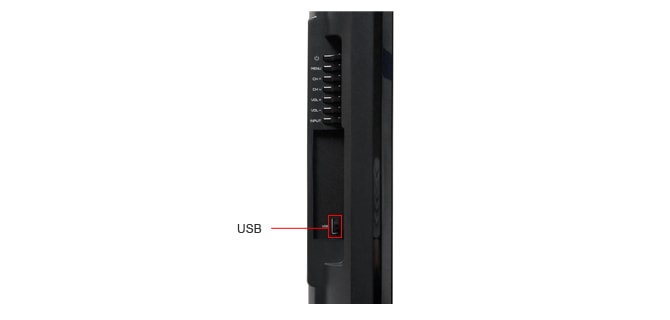
Other than the antenna port for a cable connection and the adapted composite/component connection, there is only the LAN port. The selection or ports is small, but covers the basic necessities, and the {{product.model}} could easily be used as a home theater.
{{product.manufacturer_specs['Connectivity Tour Image 3']}}
You will find all the ports in a cutout on the back left side of the display, with most of the connections on the side. Only the adapted port, the LAN connection, and the cable RF plug are arranged along the bottom. The stand swivels about 20º in either direction making access to these ports on the side very simple.
Performance
Panasonic is trying out a few new technologies with the {{product.name}}. The 2500 Focused Field Drive is a feature the pulses the activation of the plasma cells to create an overdrive refresh rate of essentially 2500Hz, which we found work great for our motion tests. This TV also comes equipped with a 16.1 built-in speaker system, a pair of 8-train, 8mm speakers on either side of the screen, and a sub woofer around the back. The audio quality was there, but these low watt speakers were too quiet for a big audience.
We saw a very deep black level, one that was at times too dark for our testing equipment, often dropping below 0.01 cd/m2. Even paired with a low peak brightness, this black level yielded an excellent contrast ratio over 3000:1. The color gamut proved to be fantastically accurate, but the detail throughout the brightness spectrum in both the primary colors and the grayscale tested sub par. It's a good panel, with some improvements on last years ST30 model (as well as some regressions), but not the best we have seen, even this year.
Contrast
{{section_header}}{{section.name}}{{/section_header}}
The superb black level on this Panasonic yields a strong contrast ratio, despite the oppressively low peak brightness. It has been a while since we saw a television show images this dimly. However, to be fair, we calibrate in cinema mode, which dims the screen for optimal viewing in darkened rooms, while also producing the most accurate colors and grayscale values. There are other modes that increase the brightness of the screen overall, but they will also affect the picture quality in a way that is less than accurate. More on how we test contrast.

Color & Greyscale Curves
{{section_header}}{{section.name}}{{/section_header}}
These color curves start out with a slope too shallow, and finish with too much steepness. This means that, in shadow, the detail distinction between values will be low. Objects in shadow will not appear as rounded as they should, rather they will be obscured in blankets of black. On the other end of the spectrum, bright colors will jump up in luminance suddenly, and gradients may show some banding as a result. The bumpy lines are a concern as well. All three lines should be perfectly smooth. Any wavering means an incorrect reproduction of the input signal. More on how we test color performance.

Color Temperature
{{section_header}}{{section.name}}{{/section_header}}
The color temperature showed errors from middle gray, all the way through the darkest images. Picture here will pick up a warm orange hue, but only a slight one. Looking at a gray value scale, from dark to light, you can see where the gray values appear to get a little warm, before they become utterly black. More on how we test color temperature.

Color Gamut
{{section_header}}{{section.name}}{{/section_header}}
The color gamut proved to be incredibly accurate. All three primary colors and the white point almost exactly match the Rec. 709, the international standard set of HDTV colors. The white point shows the most error, but it is very close to dead-on. More on how we test color temperature.
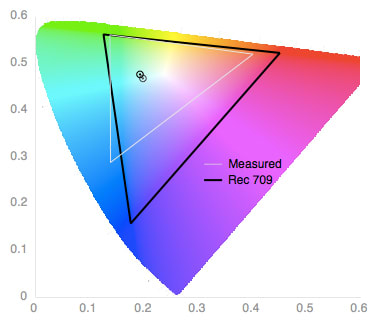
Picture Dynamics
{{section_header}}{{section.name}}{{/section_header}}
Plasma screens will dim the brightest whites and brighten the black level depending on the images shown on the screen. When there is less white, the whites become brighter, and less black, the black values get brighter. The idea is that when the screen is fully white, the plasma cells are at a high activation, and if they retained such a high peak brightness, there would be a risk of overheating the unit. The black level on the {{product.model}} gets significantly brighter when there is very little black on the screen. These small areas of black are surrounded by cells that are at a high activation level, and this high activation in such close proximity can slightly activate the cells that are supposed to be turned all the way off. The brightening of the black level means that the contrast ratio will be highest when there is quite a bit of shadow on the screen, mixed with some bright highlights. More on how we test picture dynamics.
Resolution & Formats
{{section_header}}{{section.name}}{{/section_header}}
The {{product.name}} is a native 1080p display, capable of showing NTSC and ATSC formats.
Viewing Angle
{{section_header}}{{section.name}}{{/section_header}}
The {{product.name}} is cashing in on one of the advantages plasma screens have over LCDs. Even for a plasma screen, the viewing angle was incredibly wide. The peak brightness dropped a little when moving away from the center of the screen, but so did the black level, often increasing the contrast ratio to almost 200% of the original recorded value when viewing at a 40º angle.
Reflected lights will be a problem. The peak brightness is so low that any external lights definitely diminish the visibility of the screen. We noticed that bright LED lights cast a huge gray haze over the picture, obscuring most of the images depicted there. This Panasonic would be best left in a dark environment.

Motion Performance
{{section_header}}{{section.name}}{{/section_header}}
The 2500 Focused Field Drive (FFD) function showed us some great motion performance. There is also an adjustable motion smoothness bar, which we adjusted variably throughout testing. We ran our usual motion test and saw no blur at all. Shapes did not distort either. The only nit-picking we could do was to notice minimal jagged edges, and some faint image ripple. But that was it.
The FFD function pulses the plasma cells on and off, so that the reactivation of the cells does not lag. Pulsing cells on and off is essentially the same as adding frames. A dark screen followed very quickly by a picture is exactly what happens when a screen refreshes normally. Each time the picture comes back on, it is updated with new information. In relation to the previous frame, the difference between the two pictures creates the illusion of motion. The {{product.name}} is achieving the same process but instead of rendering the second frame from top to bottom over the first frame, the entire screen shuts off and on, 2500 times per second. The result is a screen that looks and acts like it has a refresh rate of 2500Hz.
{{product.manufacturer_specs['Motion Performance Image']}}
Screen Uniformity
{{section_header}}{{section.name}}{{/section_header}}
Like most plasma screens, the {{product.model}} has a very uniform screen. An all-black screen showed no bright patches at all. It looks like a 55-inch piece of black construction paper. For commercial breaks, credit sequences, and really dark scenes in movies, there's nothing like a plasma screen.
{{product.manufacturer_specs['Screen Uniformity Image']}}
Audio Quality
{{section_header}}{{section.name}}{{/section_header}}
There are sixteen speakers on the front and a sub woofer on the back of the {{product.name}}. Each one of the speakers on the front is only 8mm thick, outputting 0.5W of power. They are arranged into two trains of eight, in dome shapes to accentuate the noise output. The addition of a sub woofer on the back is clever, and we feel, necessary addition for a stand-alone home theater. Yet, even when you add up all the wattage of the front speakers and the sub woofer, you only get 18W of power, when the average television gives you 20W with two speakers on the front.
We tested these speakers out with our usual content involving automatic rifles and surface to air missiles. The sound quality was great, and the surround mode was one of the most immersive we have tested. But the power is lacking. With the volume all the way up, in a small room, the sound was neither booming nor overwhelming. It would be hard to watch a movie with many people, such that everyone could hear. We think about the wide viewing angle and imagine that a movie party would be best supplemented by some external speakers.
Power Consumption
{{section_header}}{{section.name}}{{/section_header}}
Plasma TVs often consume a heck of a lot more power than LCDs. It is just the nature of the technology, forcing gases into a plasma state and then electrifying them into activation takes a good amount of energy apparently. In any case, this low-light emitter cost relatively little for an average year of use. At only about twice as much as an average LCD model, and an eco mode that will turn the television off when there is no signal, the {{product.model}} is definitely eco-friendly.
{{comparison_bars title="Average Cost Per Year", attribute="Minimum Recommended Cost per Year Measured", xLabel="Dollars"}}
Calibration
{{section_header}}{{section.name}}{{/section_header}}
Cinema mode is almost perfect.

All of our calibration is done in conjunction with the DisplayMate software.
](http://www.displaymate.com/)
Video Modes
{{section_header}}{{section.name}}{{/section_header}}
We start our calibrations in cinema mode always, because these settings should be the closest to ideal. Panasonic got it almost exactly right with the cinema mode on the {{product.name}}. We changed only a couple of settings by one or two points, small adjustments that could have probably been left alone anyway. We did knock the contrast down by about half, this preserved the detail in the brightest white values of the grayscale.
3D
Panasonic manufactures plenty of fine televisions, but their integration of 3D technology into their existing line-up has been an uphill struggle. Like many other successful TV brands, Panasonic's addition of 3D options and content has felt like more of an afterthought than a highlighted feature in a majority of models. This has been a problem for many companies, and for the advent of 3D technology in general: regardless of screen size or Smart content, 3D tends to generally feel like the additional extra features consumers get when they purchase those as-seen-on-TV products ("A $50 value, FREE!"). At TelevisionInfo, we tend to treat a television's 3D capability within its own sphere, outside of the TV's 2D performance and other more integral features like connection options and physical efficacy.
That said, the 3D capabilities of the Panasonic TC-P55ST50 were about average. We've definitely seen a lot worse, but during our standardized content playback, the ST50 still struggled with the usual problems: crosstalk during the real "up in your face" images, trouble upholding 3D clarity in grays and shadows when situated against graphically complex backdrops, or similarly shaded gray/black backgrounds. The glasses that, for whatever reason, don't come with the TV, are comfortable enough, but they don't allow for much, if any, flexibility in their arms or nose bridge, and don't fit terribly well over your thick-framed hipster spectacles. They do, thankfully, hold a pretty good charge, in case anyone wanted to subjugate themselves to 7 or 8 hours of shoddy 3D images.
The biggest problem with the ST50's 3D, from an objective and performance-focused outlook, is its color production. We figure most people only want to implement 3D with the idea of enjoyable high-performance immersion into their content--once the gimmick of tricking your brain wears off, watching pop-up images that are colored or shaded incorrectly just seems like an expensive and fanciful waste of time. Compared to its decent 2D color production, the 3D has some moderate, but still noticeable, color problems. This is our biggest problem with the ST50's 3D implementation, and our biggest problem with 3D as a feature.

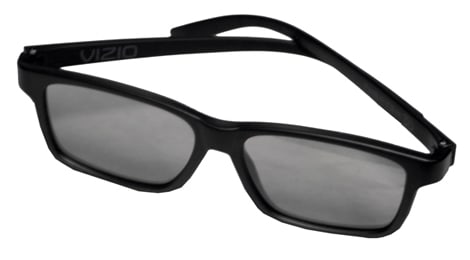
3D Effect & Experience
{{section_header}}{{section.name}}{{/section_header}}
We can't slap the ST50 on its wrist for its 3D efforts, as they weren't any worse than Panasonic's earlier implementations, but they weren't much improved either. Subtle 3D effects look great, but the close-up foreground stuff still has major crosstalk problems.
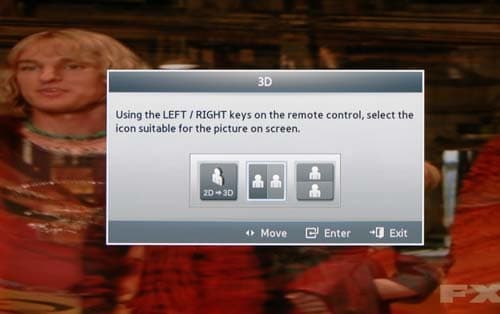
Some of the options in the 3D menu
Panasonic's current model of 3D glasses hold a nice charge, but it's a real no-no that consumers have to buy them separately. They're fairly comfortable over a long period of time, but don't leave much space to be worn on top of glasses. They're bulky and square and don't win any stylishness points.
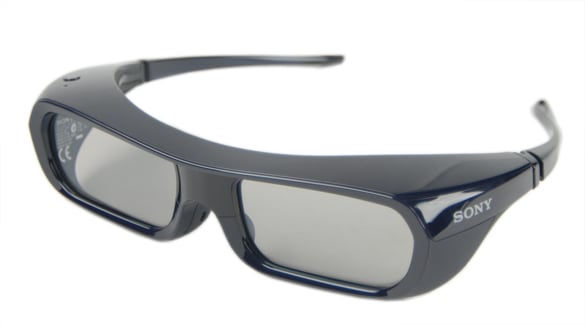
Yes, you will look like a dork with these on
3D Color
{{section_header}}{{section.name}}{{/section_header}}
As you can see from the chart, the ST50's 3D visualizations suffer from color temperature error across the entire spectrum--some of this is minor, but some of it is visible, and you'll see it during content.
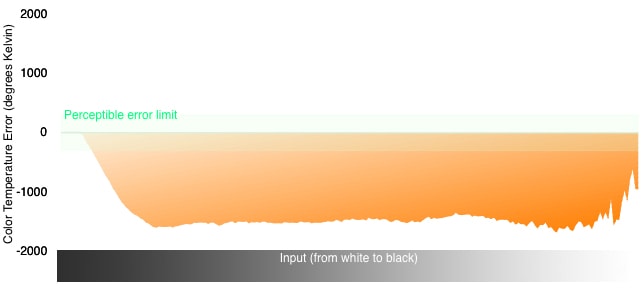
While the ST50 doesn't have perfect color curves even in 2D, its 3D curves are definitely even worse, as you can see from the chart below. We have to wonder if 3D's worth the trouble if it's going to screw with color production.
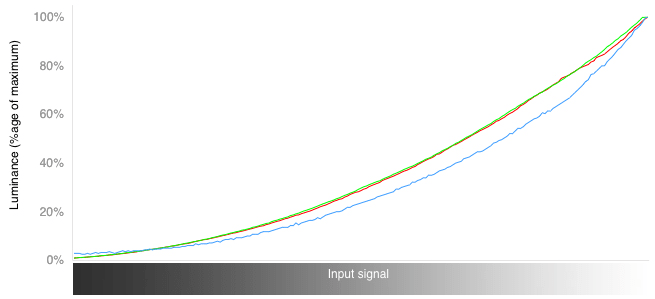
The 2D gamut, put up against the rec. 709, was decent though imperfect, but the 3D tested poorly, to no one's surprise. If you're really wowed by some kind of 3D content or are experiencing it for the first time, you likely won't notice this too much, but once the novelty wears off, it's the kind of problem to keep in mind if you're shopping specifically for the best 3D available.
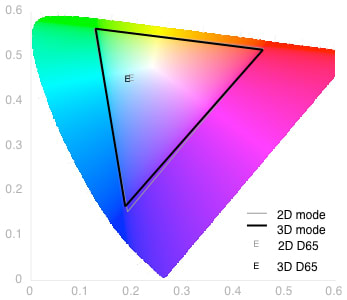
3D Crosstalk
{{section_header}}{{section.name}}{{/section_header}}
Like most 3D televisions from 2011 and 2012, crosstalk is a problem. It's not a huge problem with the ST50, but the usually culprits of same-hue background/foreground cause definitely noticeable crosstalk (which wrecks the immersion factor that 3D is going for in the first place), and of course, those 3D moments that are really pressing the limit of what they can get away with (the ones that make people avoid 3D entirely) cause some serious crosstalk issues.
Software & Internet
Browser
{{section_header}}{{section.name}}{{/section_header}}
There is no internet browser on the {{product.name}}. Sometimes we feel a lack of a browser is an unforgivable omission. If you are already connected wirelessly to a network, why prevent users from going online? This limited access reminds us much of the first days of the internet, presented by AOL, where you did not have full access to the world wide web.
On the other hand, if you don't have the controls to make a browser useful, then you shouldn't even bother. The {{product.model}} remote is not innovative enough to control a continuously more dynamic web pages with hosts of links and clickable pictures. The remote for this TV has not varied from the original blueprint of remote controllers, while the functionality of a television has changed drastically.
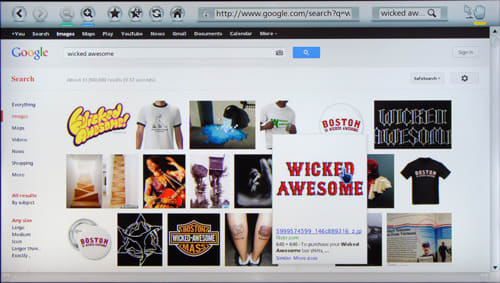
Apps
{{section_header}}{{section.name}}{{/section_header}}
Preloaded are all of the premium streaming apps, like Netflix, Vudu, Hulu, and Amazon Instant Video, an oft overlooked app in the Smart TV market. There are some extra apps here to show you what is available, as well as those that have paid to be foregrounded on your new TV. It seems Rupert Murdoch has winkled his way onto the front page of the Viera Connect menu with his Wall Street Journal app. Wonderful.
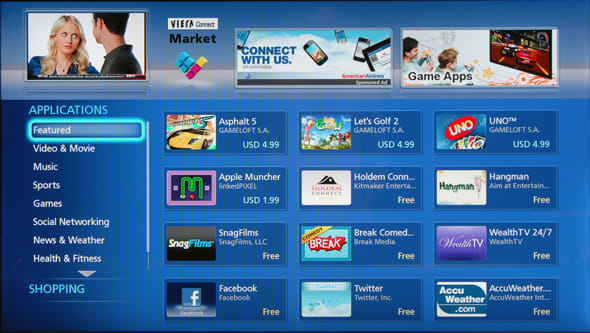
At the end of the preloaded apps, there are some blank spaces to help you load new apps, and organize the ones you already have.
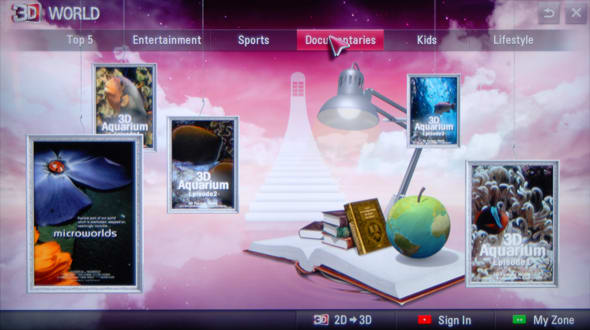
LG 3D world has more streaming 3D content by the day.
The Viera Market is both an app store and a real marketplace where you can buy physical items that will be shipped to your house. The app offerings are pretty standard. There are some crappy games, original content that we are unsure as to who makes it or how it gets into any app store, as well as useful apps from news sources and weather apps.
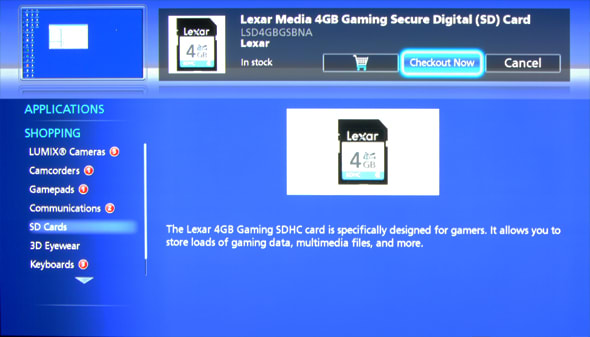
Other Internet Features
{{section_header}}{{section.name}}{{/section_header}}
Ah, social networking and television, the two go together like fried eggs and butterflies. This is one of those trends that television companies are trying to push real hard on consumers. In some ways it makes sense, you can tweet and facebook post about what you're watching without ever having to leave your screen. On the other hand, it is a shameless way to combine television shows and free marketing from people sitting on the couch. There are those that are addicted to posting all the time, there are those that may be able to work while watching TV with this function, and there are still others that we have not accounted for that may love this feature.
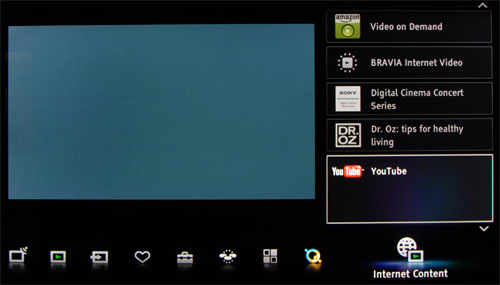
Other Media
{{section_header}}{{section.name}}{{/section_header}}
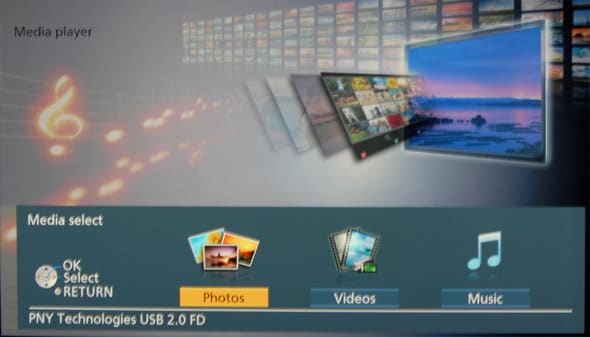
The USB port handles media easily. When you plug in a USB drive, the {{product.model}} detects the content right away. When you open up the media menu, you can choose between video, music, or photo. Selecting one of these categories has the TV search the drive for media files contained in folders, and puts the results in one big pool for you to select. For photos, you can play a slideshow, control the transition of the slides, and add music for full effect. Panasonic does not list the supported file types, but it was able to read whatever we threw at it.
Menu Interface
{{section_header}}{{section.name}}{{/section_header}}
The main menu looks very typical, like what you see on most televisions. You can select picture, sound, language and other settings from a transparent overlay that appears on the left side when you press the menu button on the remote. These menus open up into further options to select what you need. They are easy to use, but not everything is located in the same place. To get to the more advanced options, like the 3D menu and the online offerings, you have to click on the Viera Tools button to make a smaller menu appear along the bottom.

The Viera Connect front page is a menu collection of the preloaded apps, and the apps you download. There are eight squares on each page, and four total pages that you can scroll through by selecting the More button in the center of the screen.
Each of the four pages is totally customizable. In the settings "app" (we didn't know what else to call it, but it appears in this interface the same as all the other apps) all four pages turn to the side in a three-dimensional array, and you can select apps, swap them with each other, remove or add them from a list. It's very intuitive and easy to customize any of the pages.

Instruction Manual
{{section_header}}{{section.name}}{{/section_header}}
The instruction manual is frustratingly bare. There is a table of contents, but it brings you to places in the manual that do not really help. For example, the frequently asked questions section only asks questions like, why doesn't the remote work? To which the answer is, put in the batteries. Other than this, there are many specifications missing all together. Which model of 3D glasses works best with the {{product.name}}, you know, because none come with the purchase of this TV? Well, you won't find the answer in the manual. How much internal memory does the {{product.model}} have, so when I download a bunch of apps and buy movies from Amazon, I will know when I reach my limit. There is no mention of this in the manual. If a company is going to offer so much with their product, they should be held to the standard of detailing it all as well.
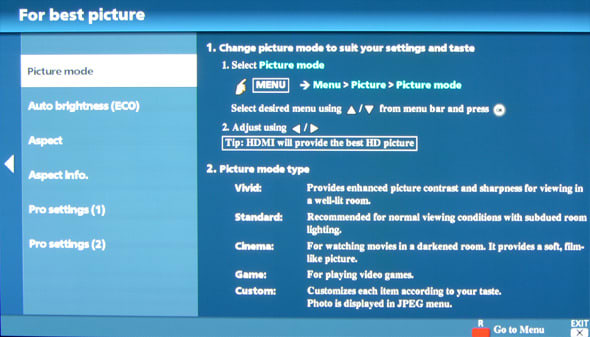
There is also an on-board e-manual. You can search for terms in here as well, but the information mirrors the paper manual, and we could still not find helpful answers to our frequently asked questions.

A manual for so many TV models, they have to be further categorized by type.
Value Comparison
{{section_header}}{{section.name}}{{/section_header}}
These two televisions are similarly priced, even though the {{product.name}} is a few sizes larger than the LG 47LM6700, but our money goes with the LG. It is a hard call to make, both are solid displays, but the LG has some of the best all-around quality we have seen in a while, as well as one of the best Smart TV manifests and the best 3D images we have ever seen. When you want to spend this much on a great TV for the best features, we think you will be disappointed when it's not the best. Conversely, you may just want a 55-inch plasma screen for watching sports in a darkened mancave, in which case the {{product.name}} is the way to go.
Blacks & Whites
{{section_header}}{{section.name}}{{/section_header}}
The LG 47LM6700 showed us a very disappointing black level during testing, and the result was an unsatisfying contrast ratio. However, the LG did not have brightness problems like the {{product.name}}, which has a strong contrast ratio but will not be optimal for a well-lit room.

Color Accuracy
{{section_header}}{{section.name}}{{/section_header}}
Both of the color temperature charts show some errors. The LG 47LM6700 produced some cooling errors, but only at the darkest end of the spectrum where most images are black, lacking any hue at all. The {{product.name}} conversely had some noticeable warm hints to images in the middle of the brightness spectrum.
The color curves for the LG shown below are pretty close to ideal, minus some finer detail in shadows. The {{product.name}} in comparison looks frazzled, losing detail all over the place and producing incorrect values for the given input.
We think the LG is a better television for color fidelity.
Screen Performance
{{section_header}}{{section.name}}{{/section_header}}
The {{product.name}} trounces the LG 47LM6700 in both viewing angle and motion processing, which are advantages of plasma screens. For an LCD, the LG 47LM6700 has a great viewing angle and shows moving objects well, but nothing like this 85º off-center viewable television with 2500 FFD.
Connectivity
{{section_header}}{{section.name}}{{/section_header}}
The {{product.name}} has one less HDMI port than the LG 47LM6700, but it adds an SD Card slot for the photographically inclined. Otherwise, the main attributes are covered, like WiFi and USB media access.
Value Comparison
{{section_header}}{{section.name}}{{/section_header}}
The Samsung PN51D6500 is significantly cheaper than the {{product.name}}, especially considering that it can be found much cheaper as it is last year's model. Much of the performance is comparable, and in some categories, like color production, the Samsung PN51D6500 comes out way ahead. We also have a great appreciation for the Samsung Smart Hub, a fantastic collection of all this TV's features in one area. You can't go wrong with the Samsung PN51D6500, unless the lack of built-in WiFi is going to ruin your setup.
Blacks & Whites
{{section_header}}{{section.name}}{{/section_header}}
The Samsung PN51D6500 has a better contrast ratio because it has an acceptable peak brightness. We think you could watch the Samsung just about anywhere in your home, other than the sun conservatory wing (you have one of those right?). The {{product.name}} is certainly watchable, and has that great black level, but the peak brightness will make it difficult to watch in a sunny room, or any room with lamp lighting.

Color Accuracy
{{section_header}}{{section.name}}{{/section_header}}
These two TVs share similar errors in color temperature and should be considered comparable.
The Samsung PN51D6500 color curves are almost perfect, with some minor bumps along the way. The {{product.name}} does not share this level of quality.
Screen Performance
{{section_header}}{{section.name}}{{/section_header}}
The Samsung PN51D6500 and the {{product.name}} had almost identically wide viewing angles.
In terms of motion performance, the {{product.name}} seems to exceed the Samsung PN51D6500 employing the 2500FFD technology to its advantage.
Connectivity
{{section_header}}{{section.name}}{{/section_header}}
The {{product.name}} clearly has better connectivity than the Samsung PN51D6500, given the SD card slot and built-in WiFi.
Value Comparison
{{section_header}}{{section.name}}{{/section_header}}
Here we compare last year's model to the 2012 version to identify any updates, and frankly we don't like what we see. Last year, the contrast ratio was greater, the color accuracy more accurate, there have been no new ports added, nor has the online interface been updated at all. The biggest advancement we noticed was the 2500FFD function, which seems to have improved the motion processing, but this is not enough to constitute a whole new line of more expensive televisions in our regard. Look to get last year's model if you are considering this TV at all.
Blacks & Whites
{{section_header}}{{section.name}}{{/section_header}}
The ST30 has the advantage here with the same black level, and a much better peak brightness.

Color Accuracy
{{section_header}}{{section.name}}{{/section_header}}
Both the color temperature and the color detail proved to be better on the ST30 from last year.
3D
{{section_header}}{{section.name}}{{/section_header}}
The newer Panasonic did not wow us with its 3D effect, but it was still better than last year's showing, if only by a marginal amount. While both are still not great with very "close" foreground effects, the subtle middle and background 3D on the ST50 is superior.

Yes, you will look like a dork with these on
Screen Performance
{{section_header}}{{section.name}}{{/section_header}}
The viewing angle seems to have improved slightly from last year, but the big improvement is the motion processing. The 2500FFD has eliminated all of the chunky artifacts we saw last year.
Connectivity
{{section_header}}{{section.name}}{{/section_header}}
The connectivity has not changed from last year.
Other Comparisons
{{section_header}}{{section.name}}{{/section_header}}
What also has not changed, to our surprise and chagrin, is the online interface. It's still really slow and the content very limited. There seem to be no advancements here, where a simple overhaul of the user interface would have greatly improved the overall usability.
Conclusion
{{product.vanity}}
Though the {{product.name}} ($1699 MSRP) may have some great attributes, it lacks in some area of convenience concerning the internet and 3D.
First off, the active shutter glasses just do not produce the 3D you have always hoped and dreamed for. Rather than an improvement on 2D, this type of 3D is a novelty that we can't imagine consumers will use regularly. If we are talking internet features, the streaming content is there, and it's easy to use, but it's also slow to load and navigate. Furthermore, it's exactly the same as it was last year, both in look and ineptitude. Consumers will definitely use this function, as it is one of the main features of a Smart TV, but there are much better systems out there.
In the end, the {{product.name}} isn't a bad TV, but it's not the super-powered, modern multi-tasker we expected, nor is it an improvement on last year's ST30. If you just want a sports television, you can save some money by buying a Panasonic plasma with none of these lackluster advanced features. The price is similar to other televisions of the 3D Smart TV ilk, and we think it is worth the time to look at a few other brands before you commit to the Panasonic interface, and underwhelming Active 3D images.
Model Series Comparison
{{section_header}}{{section.name}}{{/section_header}}
The TC-PxxST50 is one series in Panasonic's high-end plasma models. Each of these televisions is a native 1080p plasma display, capable of 3D images and connecting to the internet for streaming content. This series employs some of Panasonic's new features like Infinite Black Pro, 2500 Focused Field Drive screens, 16.1 speakers, and interconnectivity with devices around your house.
Photo Gallery
{{photo_gallery "Design Landing Page Photo", "Front Tour Image", "Back Tour Image", "Sides Tour Image", "Connectivity Tour Image 1", "Connectivity Tour Image 2", "Stand Photo", "Controls Photo", "Remote Control Photo", "3D Landing Page Photo", "3D Menu Photo", "3D Glasses Photo", "Connectivity Extra Photo", "Software and Internet Landing Page Photo", "Menu Main Photo", "Menu 2 Photo", "Instruction Manual Photo", "Internet Features 1 Photo", "Internet Features 2 Photo", "Internet Features 3 Photo", "Local Media Playback 1 Photo", "Local Media Playback 2 Photo", "Browser 1 Photo", "Browser 2 Photo", "Browser 3 Photo", "Apps 1 Photo", "Apps 2 Photo", "Apps 3 Photo"}}
Ratings & Specs
{{manufacturer_specs_table}}
Meet the tester
Christian Sherden is a valued contributor to the Reviewed.com family of sites.
Checking our work.
Our team is here for one purpose: to help you buy the best stuff and love what you own. Our writers, editors, and lab technicians obsess over the products we cover to make sure you're confident and satisfied. Have a different opinion about something we recommend? Email us and we'll compare notes.
Shoot us an email


